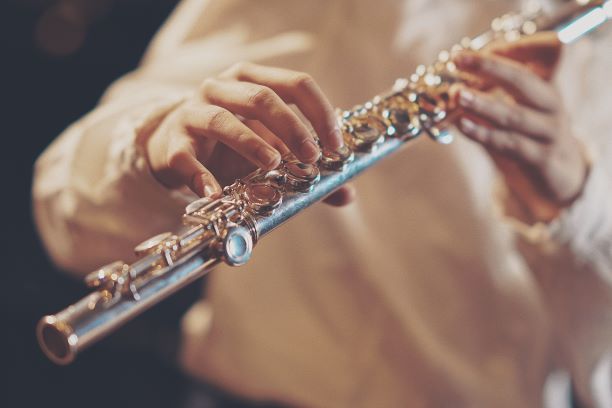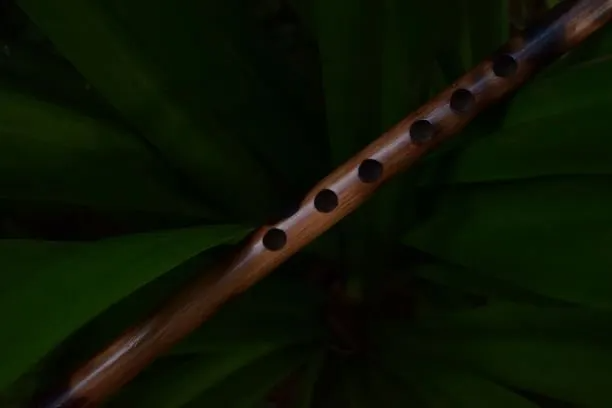Matthews Music
On playing the flute
The best performers on any instrument tend to be naturally built for that instrument (the great violinist Paganini, reputed to have sold his soul to the devil in exchange for his marvellous technique, is reputed to have had one shoulder higher than the other). Every instrument poses its own problems, and the flute has its fair share. A correct and well-balanced posture is a prerequisite for the mastery of the flute (and indeed, any instrument). The feet should be neither too close nor too far apart; the left foot will probably be slightly in advance of the right. The flute is supported at three points; on the chin, in the crook of the left forefinger, and with the right thumb. While it must feel secure, the flute must rest in place; it should not be gripped, and the instrument should not be pressed in to the chin, as the lips must be free to vibrate.While the upper arms should be relaxed as much as possible, the right arm should be extended to some extent, to give the player room to breathe. and for the development of controlled breathing, from the diaphragm, so essential for good flute playing. Indeed, posture and breathing, taken together, probably amount to seventy-five per cent of flute playing. The secret of flute playing is largely breathing deeply, through the mouth, when you can. The extent to which the mouthhole is covered is critical; probably not more than a third to two-fifths. It is also important to keep the throat relaxed and as open as possible, as any constriction will reduce the sound, and the whole of the airway, from the diaphragm to the lips, acts as a soundbox or resonator
The old advice to woodwind players was 'think of the sound you want to make, then make it'. Would it were so simple. The lips have to be strong yet flexible; while they should always be everted, the first rule is to always keep the embouchure as relaxed as possible. Especially when playing in altissimo, the most testing part of the tessitura, there may be a tendency to tighten up; this must be resisted, as a generous sound cannot be produced with a tight embouchure. A first-class embouchure will disturb the lips as little as possible from a position of repose, and will change very little over the range, although there will be some adjustment for the angle of blowing. It can help to match the curve of the top lip to the curve of the embouchure hole; this will help to force all the air into the flute to produce the bottom octave, or fundamental, sound. The airstream splits on the edge of the mouthhole to produce the second octave, so a flatter airstream is called for. However, the top lip should always be in advance of the bottom lip; the lip plate supports the bottom lip, which in turn supports the top lip. In fact, a good embouchure looks rather like a closed pair of scissors; in contact for most of their length and straight, with the maximum amount of bottom lip on the lip plate. The 'flute player's' smile, in which the corners of the mouth are retracted, should be avoided at all costs.
The keys on the flute do not generate sound and fingering should be as light as possible; imagine the fingers are glued to the keys. The tongue should be kept behind the teeth. A controlled flute vibrato is not easily acquired, although I have had a few school students who possessed it naturally; a quick, uncontrolled vibrato is an indication of shallow breathing. Practising with a metronome can help to develop it, aiming initially for a very slow, broad vibrato, and gradually increasing the speed as control is gained. The player needs to use his or her artistic judgement to vary the speed and intensity of the vibrato,
As a student, I was told to practise in the dark (assuming I had memorised the piece); the aim is to shut out all external influences, and concentrate on the sound and the line. Practising simple melodies, such as folk songs, can be helpful in learning how to plan breathing and shape the phrase. The flute student, working on phrasing can have few better models than Pablo Casals' recording of the Bach cello suites.
The other piece of my teacher, Derek Honner's advice that has stuck with me is that playing the flute is as much a question of not doing things as doing things. The impetus comes from the diaphragm; elsewhere there should be as little movement as possible. Finger movement should be minimal, and the embouchure should change little. Less is more. Effort defeats itself.
.


